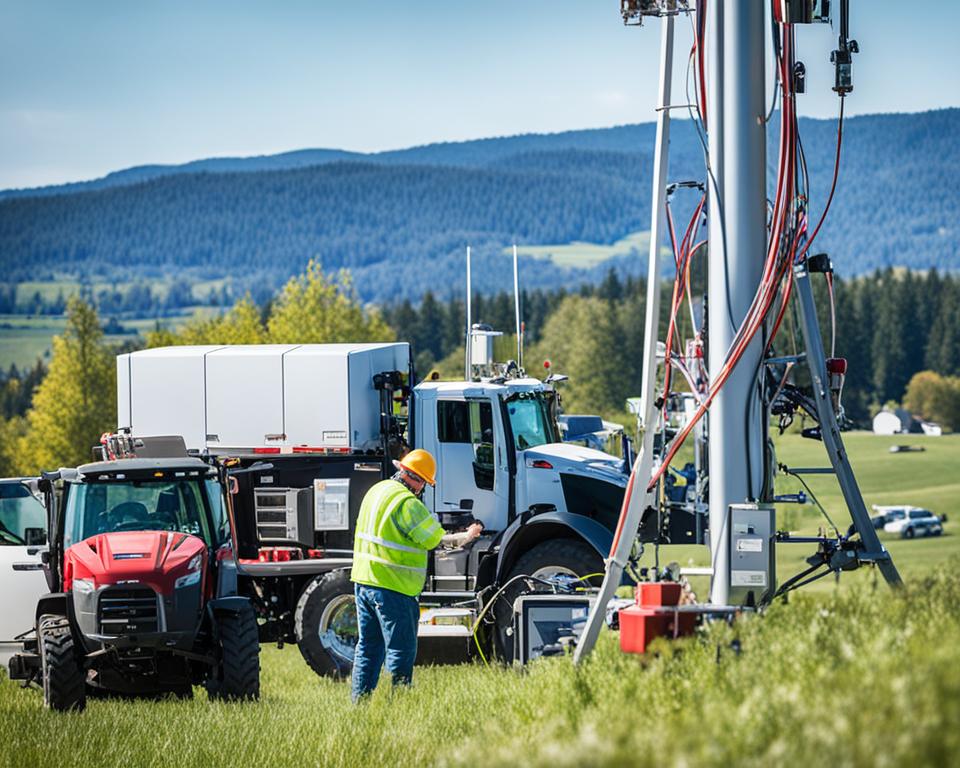Did you know that over 14% of the global population still lacks access to electricity?
In today’s digital age, reliable internet access is essential for education, healthcare, business, and social interaction. However, many rural areas still face a significant challenge when it comes to high-speed broadband services, creating a digital divide. Without a reliable internet connection, people in remote villages are unable to access streaming services, online education resources, telemedicine, and other benefits of the digital world.
Key Takeaways:
- Rural areas still face a digital divide in terms of high-speed broadband access.
- Limited connectivity in remote villages hinders access to online resources and services.
- IPTV and other connectivity solutions offer opportunities to bridge the digital divide in rural areas.
- By addressing funding, engineering, regulatory compliance, security, equipment procurement, and fiber-optic infrastructure, rural connectivity can be improved.
- Bridging the digital divide in rural areas is crucial for education, healthcare, and economic growth.
The Digital Divide in Rural Areas
The digital divide refers to the uneven distribution of internet access and technology between different regions or communities. In rural areas, this divide is particularly pronounced, with limited access to high-speed broadband services. The lack of reliable internet connectivity in these areas hinders their ability to fully participate in the digital world, impacting various aspects of daily life, such as education, healthcare, and economic opportunities.
Rural areas often face several challenges when it comes to accessing high-speed broadband and reliable internet service. These challenges include:
- Underdeveloped or outdated infrastructure that cannot support high-speed internet connections
- Limited availability of internet service providers (ISPs) in remote locations
- Higher costs of deploying broadband infrastructure in sparsely populated areas
- Geographical barriers, such as rugged terrains or long distances between households, making it difficult to establish connectivity
The impact of the digital divide in rural areas is significant. It affects the quality of education available to students, as they may lack access to online learning resources and opportunities for digital skill development. In terms of healthcare, limited internet access can hinder telemedicine services, preventing residents from receiving timely medical care and consultations. Additionally, the lack of high-speed broadband inhibits the growth of businesses and entrepreneurship in rural areas, limiting economic opportunities and job prospects for residents.
Efforts are being made to bridge the digital divide in rural areas. Governments, non-profit organizations, and ISPs are working together to develop innovative solutions and expand internet coverage. Initiatives include:
- Investing in the development of broadband infrastructure in rural areas
- Providing financial incentives to ISPs to expand their services in underserved regions
- Encouraging public-private partnerships to leverage resources and expertise
- Exploring alternative connectivity solutions, such as satellite internet and wireless technologies
The image above depicts the importance of high-speed broadband in bridging the digital divide in rural areas. It highlights the potential of internet access to connect remote communities, empower individuals, and foster economic growth.
In the next section, we will explore the challenges faced in rural broadband deployment and the efforts being made to overcome them.
Challenges Faced in Rural Broadband Deployment
Deploying broadband services in rural areas presents a unique set of challenges for internet service providers (ISPs). These challenges encompass various aspects, including infrastructure limitations and financial constraints. Overcoming these obstacles is crucial to bridging the digital divide and ensuring equitable access to high-speed internet in remote communities.
Lack of Infrastructure
One of the primary challenges in rural broadband deployment is the inadequate infrastructure. Remote areas often lack the necessary network infrastructure to support broadband services. This includes the absence of fiber-optic cables or other reliable means of transmitting data over long distances. Without a robust network infrastructure, ISPs find it challenging to provide fast and reliable broadband connectivity to rural communities.
Limited Financial Resources
Securing the financial resources needed for rural broadband deployment is another significant hurdle. Developing the necessary infrastructure, maintaining network equipment, and providing ongoing support require substantial investments. However, the potential returns on these investments may be uncertain or take longer to materialize in rural areas. This financial uncertainty creates a barrier for ISPs looking to extend broadband services in remote locations.
Engineering Expertise
Deploying broadband services in rural areas requires engineering expertise tailored to the unique challenges of remote environments. ISPs must possess the skills to design and implement network architectures that can withstand the geographical obstacles and provide reliable connectivity. Finding skilled engineers familiar with rural broadband deployment can be a challenge in itself, further exacerbating the difficulties faced by ISPs.
Regulatory Compliance
Complying with regulatory requirements adds another layer of complexity to rural broadband deployment. ISPs must navigate local, state, and federal regulations to obtain permits and ensure compliance with legal obligations. These regulations may vary from region to region, lengthening the deployment timeline and adding additional costs for ISPs.
Network Security
Ensuring network security is crucial in rural broadband deployment. Remote areas can be particularly vulnerable to cyber threats due to limited monitoring capabilities and the absence of comprehensive security measures. ISPs must invest in robust cybersecurity systems to protect network infrastructure and customer data from breaches and unauthorized access.
In summary, rural broadband deployment faces significant challenges related to infrastructure, financial resources, engineering expertise, regulatory compliance, and network security. Overcoming these obstacles requires collaboration between ISPs, government agencies, and community stakeholders to ensure that reliable and affordable broadband services reach every corner of the country.

Leveraging Funding Opportunities for Rural Broadband
Securing funding is crucial for the successful deployment of rural broadband. Internet service providers (ISPs) can tap into various funding opportunities such as government grants, private investments, and subsidies to finance the necessary infrastructure and cover operational expenses. By leveraging these funding sources, ISPs can bridge the digital divide and ensure effective broadband deployment in rural areas.
Government Grants
Government grants are a significant funding source for rural broadband projects. Federal, state, and local governments allocate funds to promote connectivity in underserved areas. These grants provide financial assistance to ISPs, allowing them to expand their network infrastructure and improve broadband access in rural communities. Government grants often come with specific eligibility criteria and application processes, and ISPs must navigate through these requirements to secure funding.
Private Investments
Private investments offer another avenue for funding rural broadband projects. Investors seek opportunities to invest in telecommunications infrastructure, recognizing the long-term potential and value of expanding broadband access in rural areas. ISPs can partner with private investors, securing the capital needed to build and maintain robust broadband networks. Private investments enable ISPs to accelerate the deployment process and reach underserved communities more efficiently.
Subsidies
Subsidies are financial incentives provided by governments to support certain industries or initiatives. In the context of rural broadband, subsidies can be offered to ISPs to lower the cost of deploying and operating broadband networks in remote areas. These subsidies aim to incentivize ISPs to extend their services and bridge the connectivity gap in rural communities. By offsetting some of the expenses, subsidies make broadband deployment financially viable for ISPs, especially in areas with low population density.
| Funding Opportunity | Description |
|---|---|
| Government Grants | Funding provided by federal, state, or local governments to support broadband deployment in underserved rural areas. |
| Private Investments | Capital provided by private investors to finance the construction and operation of broadband networks in rural communities. |
| Subsidies | Financial incentives offered by governments to ISPs to reduce the cost of deploying and maintaining broadband infrastructure in rural areas. |
By capitalizing on these funding opportunities, ISPs can overcome financial barriers and bring high-speed broadband to remote villages and underserved rural areas. The availability of diverse funding sources ensures that ISPs have the necessary resources to invest in the infrastructure and technology required for reliable and widespread rural connectivity.
Engineering Solutions for Rural Broadband Networks
Engineering plays a crucial role in designing and deploying robust broadband networks in rural areas. Skilled engineers collaborate with Internet Service Providers (ISPs) to plan and design networks tailored to the unique needs of each rural community. By utilizing innovative engineering solutions, ISPs can overcome the challenges associated with rural broadband deployment and enhance connectivity in remote areas.
Network Design
One of the key aspects of engineering solutions for rural broadband networks is network design. Engineers work closely with ISPs to assess the infrastructure requirements, coverage areas, and user demands. Through thorough analysis, they develop network designs that maximize efficiency and coverage while minimizing costs. This includes determining the optimal placement of network equipment, such as routers and access points, to ensure seamless connectivity throughout the rural community.
Site Surveys
Site surveys are essential in the engineering process of rural broadband networks. Engineers conduct surveys to evaluate the geographical characteristics of the area, identify potential obstacles, and assess signal propagation. By analyzing topography, vegetation, and existing infrastructure, engineers can design network layouts that optimize signal strength and minimize interference. Site surveys also help identify suitable locations for network equipment installation, ensuring effective coverage and connectivity.
Network Architecture
The network architecture of rural broadband networks is carefully designed to ensure efficient and scalable deployments. Engineers utilize various architectural frameworks, such as point-to-multipoint or mesh networks, to create reliable connections between users and network infrastructure. This allows for the expansion of the network as demand grows, accommodating the evolving needs of the rural community. Additionally, engineers implement redundancy measures to ensure network resilience and minimize downtime, enabling uninterrupted broadband access for users.

| Benefits of Engineering Solutions for Rural Broadband Networks |
|---|
| 1. Enhanced Coverage: Engineering solutions enable ISPs to design networks that cover a larger area, extending connectivity to remote villages and underserved regions. |
| 2. Improved Performance: By optimizing network design and architecture, engineers ensure high-speed and reliable internet access for rural communities. |
| 3. Scalability: The scalable nature of engineered networks allows for future expansion and growth, accommodating the increasing demand for broadband services. |
| 4. Cost Efficiency: Through careful planning and design, engineering solutions help minimize deployment costs while maximizing the effectiveness of the network infrastructure. |
Ensuring Compliance in Rural Broadband Deployment
Rural broadband deployment involves navigating complex regulatory processes at federal, state, and local levels. Internet Service Providers (ISPs) must ensure compliance with regulations, obtain necessary permits, and adhere to regulatory processes to avoid delays and legal complications. The compliance challenges in rural broadband deployment can be significant, requiring meticulous attention to detail and a comprehensive understanding of the regulatory landscape.
Regulations governing rural broadband deployment vary across different jurisdictions, making it essential for ISPs to conduct thorough research and engage legal experts familiar with the specific regulatory requirements in each area. By doing so, ISPs can avoid potential fines, penalties, or project delays due to non-compliance.
One of the key regulatory processes in rural broadband deployment is obtaining the necessary permits from local authorities. These permits ensure that the infrastructure installation complies with local regulations, environmental standards, and zoning laws. ISPs must work closely with municipalities, government agencies, and community stakeholders to obtain the required permits efficiently and effectively.
In addition to permits, ISPs need to comply with various regulatory processes that govern the entire project lifecycle, from planning and construction to operation and maintenance. These regulatory processes may include environmental impact assessments, safety regulations, and quality control standards. By staying informed and adhering to these processes, ISPs can not only mitigate legal risks but also build trust with communities and government stakeholders.
Navigating Compliance Challenges
Compliance challenges in rural broadband deployment can arise due to factors such as:
- Diverse regulatory frameworks across different jurisdictions
- Varying permit requirements and application procedures
- Changing regulatory landscape and evolving policies
- Complex environmental considerations
- Community engagement and public consultations
ISPs can navigate these compliance challenges effectively by following a proactive and strategic approach:
- Developing a compliance roadmap: ISPs should conduct a comprehensive assessment of the regulatory landscape and develop a roadmap that outlines all necessary compliance steps and timelines.
- Engaging legal experts: Seeking legal counsel with expertise in telecommunications regulations and rural broadband deployment can provide valuable guidance in navigating complex compliance requirements.
- Building relationships with regulatory bodies: ISPs should establish open lines of communication with regulatory authorities to seek clarification on compliance obligations and address any concerns promptly.
- Investing in compliance training: Training staff members involved in the deployment process on compliance best practices can help ensure that all activities are conducted in accordance with applicable regulations.
- Regular compliance audits: Conducting periodic audits to assess compliance with regulations and identify any gaps or areas for improvement is essential for ongoing regulatory adherence.
In conclusion, compliance is a critical aspect of rural broadband deployment. ISPs must navigate complex regulatory processes, obtain permits, and comply with regulations to ensure timely and legal adherence to project requirements. By proactively addressing compliance challenges and adopting a strategic approach, ISPs can successfully deploy broadband infrastructure in rural areas while complying with regulatory frameworks.
Securing Rural Broadband Networks
In today’s digital landscape, securing rural broadband networks is of paramount importance. As the reliance on internet connectivity in remote areas increases, so does the need to safeguard networks from cyber threats and protect valuable customer data. This section will delve into the security challenges faced in rural broadband deployment and highlight the solutions offered by trusted security experts within the industry.
The Importance of Network Security
Network security is crucial in ensuring the integrity and confidentiality of data transmitted over rural broadband networks. With cyber threats becoming more sophisticated, it is imperative for internet service providers (ISPs) to implement robust security measures that prevent unauthorized access, data breaches, and service disruptions.
Challenges in Rural Broadband Deployment
Rural broadband deployment presents unique challenges when it comes to network security. The lack of existing infrastructure and limited financial resources make it difficult for ISPs to allocate substantial budgets for comprehensive security measures. Furthermore, the dispersed nature of rural communities increases the risk of unauthorized access and physical tampering of network equipment.
Solutions Offered by Security Experts
To address these challenges, security experts specialize in offering tailored solutions designed specifically for rural broadband networks. These solutions combine industry best practices, cutting-edge technologies, and proactive threat intelligence to protect against a wide range of cyber threats.
Security experts collaborate with ISPs to implement the following measures:
- Firewall Protection: Installing robust firewalls to filter and monitor incoming and outgoing network traffic, effectively blocking unauthorized access attempts.
- Intrusion Detection and Prevention Systems (IDPS): Deploying IDPS solutions that continuously monitor network activity, detect suspicious behavior, and prevent potential attacks.
- Encryption: Implementing encryption protocols to secure data transmissions and prevent interception by unauthorized entities.
- Regular Audits and Vulnerability Assessments: Conducting regular audits and vulnerability assessments to identify and address potential security weaknesses in the network infrastructure.
- Employee Education and Training: Providing comprehensive training programs to ensure that employees are aware of the importance of network security and follow best practices to safeguard customer data.
By partnering with experienced security experts, ISPs can enhance the resilience of their rural broadband networks and safeguard the data and privacy of their customers.

| Security Measures | Description |
|---|---|
| Firewall Protection | Installing robust firewalls to filter and monitor network traffic, blocking unauthorized access attempts. |
| Intrusion Detection and Prevention Systems (IDPS) | Deploying IDPS solutions to monitor network activity, detect suspicious behavior, and prevent potential attacks. |
| Encryption | Implementing encryption protocols to secure data transmissions and prevent interception by unauthorized entities. |
| Regular Audits and Vulnerability Assessments | Conducting regular assessments to identify and address security weaknesses in the network infrastructure. |
| Employee Education and Training | Providing comprehensive training to ensure employees follow best practices and uphold network security protocols. |
Ensuring Affordable Equipment Procurement
When it comes to rural broadband deployment, procuring equipment and materials at competitive prices is a key factor in ensuring the financial feasibility of the project. By accessing wholesale pricing through partnerships and networks, Internet Service Providers (ISPs) can significantly reduce deployment costs, making high-speed broadband more accessible in remote areas.
One of the main advantages of affordable equipment procurement is the potential for cost savings. ISPs can acquire the necessary networking equipment, cables, and other components at competitive prices, optimizing their budgets and maximizing the value of each investment. This allows them to allocate resources more efficiently to expand coverage and improve connectivity in rural communities.
Furthermore, wholesale pricing offers ISPs the opportunity to collaborate with trusted suppliers and manufacturers who can provide reliable and high-quality equipment. By establishing strong partnerships, ISPs can access a wide range of products and services tailored specifically to their unique needs and requirements.
Another significant benefit of affordable equipment procurement is the ability to scale operations effectively. With competitive pricing, ISPs can overcome financial barriers that often inhibit the expansion of broadband services in underserved areas. This enables them to deploy the necessary infrastructure and equipment to connect more remote villages and bridge the digital divide.
To illustrate the advantages of affordable equipment procurement, consider the following table:
The Role of Fiber Optics in Rural Connectivity
Fiber optics plays a pivotal role in delivering high-speed data transmission in rural areas. With its ability to transmit large amounts of data over long distances, fiber optics provides a reliable and efficient connectivity solution for remote villages.
By harnessing the power of fiber optics, connectivity providers can offer exceptional broadband services to businesses and industries in rural communities. The extensive fiber-optic infrastructure enables seamless data transmission, allowing these businesses to access critical online resources, communicate effectively, and expand their reach.
Advantages of Fiber Optics in Rural Broadband Deployment
1. High-Speed Data Transmission: Fiber optics allows for incredibly fast data transmission speeds, enabling rural areas to enjoy high-quality internet experiences, including smooth streaming, video conferencing, and online collaboration.
2. Reliability: Fiber optic cables are not susceptible to interference from electromagnetic signals or environmental factors, ensuring consistent and reliable connectivity even in harsh weather conditions.
3. Scalability: Fiber optics offer scalable solutions that can cater to the growing demand for bandwidth in rural areas. As the need for faster speeds and increased data capacity arises, fiber networks can easily be upgraded and expanded.
4. Secure Data Transmission: Fiber optics provide enhanced security compared to traditional copper cables. They are more resistant to hacking and eavesdropping, offering a secure data transmission environment for businesses and individuals in rural communities.
5. Future-Proof Infrastructure: Fiber optics represent a long-term investment in rural connectivity. As technology advances and data demands continue to grow, fiber networks can accommodate these changes without the need for extensive infrastructure upgrades.
The Impact of Fiber Optics on Overall Connectivity
With the integration of fiber optics in rural broadband deployment, the overall connectivity landscape in remote villages undergoes a transformative change. The advantages of fiber optics contribute to:
- Enhanced educational opportunities through access to online learning resources and virtual classrooms.
- Improved healthcare services with telemedicine capabilities, enabling remote consultations, diagnostics, and monitoring.
- Increased economic growth by attracting businesses, stimulating entrepreneurship, and creating job opportunities in rural areas.
- Expanded access to government services, public safety systems, and emergency communication networks.
- Enriched social connectivity and community engagement through seamless online interactions and access to social media platforms.
With its numerous advantages and significant impact on overall connectivity, fiber optics serve as a crucial component in bridging the digital divide in rural areas. The integration of fiber-optic infrastructure by connectivity providers paves the way for reliable, high-speed data transmission, empowering businesses, and improving the quality of life in remote villages.
Conclusion
Bridging the digital divide in rural areas is a pressing issue that requires concerted efforts from various stakeholders. Throughout this article, we have explored the challenges faced in rural broadband deployment and the solutions offered by ISPs to enhance rural connectivity. By leveraging funding opportunities, engineering expertise, compliance with regulations, network security measures, affordable equipment procurement, and fiber-optic infrastructure, providers can bridge the gap and provide high-speed broadband access to remote villages.
It is evident that closing the digital divide is crucial for the overall development of rural communities. Access to reliable internet service empowers individuals with educational resources, enables telehealth services, and creates economic opportunities. Through collaboration and innovation, we can ensure that no one is left behind in the digital era.
As technology continues to advance and the demand for connectivity grows, it is imperative that governments, private organizations, and community leaders work together to prioritize rural connectivity. By investing in infrastructure, promoting competition, and implementing policies that support broadband deployment, we can bridge the digital divide and create a more inclusive and connected society. Together, we can unlock the full potential of rural areas and pave the way for a prosperous future for all.
FAQ
What is the digital divide?
How does the digital divide affect rural areas?
What challenges are faced in rural broadband deployment?
How can ISPs secure funding for rural broadband projects?
What role does engineering play in rural broadband networks?
How do ISPs navigate regulatory processes in rural broadband deployment?
How do ISPs secure rural broadband networks?
How can ISPs ensure affordable equipment procurement for rural broadband deployment?
What is the role of fiber optics in rural connectivity?
How can the digital divide be bridged in rural areas?






